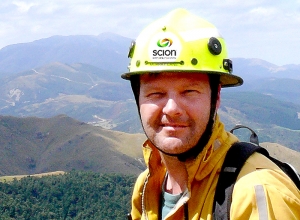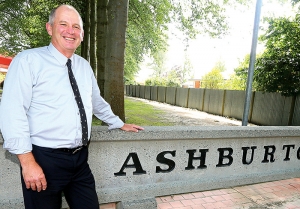Search

 Defender Mia Pearson has been named in a Netball New Zealand emerging talent squad. Photo suppliedUp and coming Mid Canterbury netball player Mia Pearson has gained the attention of Netball New Zealand’s emerging talent selectors.
Defender Mia Pearson has been named in a Netball New Zealand emerging talent squad. Photo suppliedUp and coming Mid Canterbury netball player Mia Pearson has gained the attention of Netball New Zealand’s emerging talent selectors.
Ashburton College student Pearson has been named in a 50-strong squad of players to attend a development camp in Auckland early next year where she will get the opportunity to learn and be guided by some of the best players in the land.
The group of athletes will be split into five teams to be coached by Pathway to Podium coaches Irene van Dyk, Jo Morrison, Temepara Bailey, Sandra Edge and Anna Galvan.
The head coaches will be joined by five apprentice coaches in the Performance Coach Qualification pathway while umpires and umpire coaches have also been invited to attend the four-day camp.
Pearson is the only local player to have been included in the squad and one of only nine players from the Mainland Netball Zone which covers most of Canterbury.
Netball New Zealand Head of High Performance Keir Hansen said the National Development Camp would give the athletes an insight into the Netball New Zealand pathway.
“For many, this is their first step into that elite environment and an opportunity for us to inspire our developing players building towards their future,” he said.
Athletes will undergo a series of movement competency screenings to assess their readiness for performance.
The group will be observed on their performance under pressure with a highly competitive short tournament structure to be employed during the camp.
“This is a best on best environment where our Emerging Talent Selectors will be able to continue profiling our future pathway athletes,” Hansen said.
Selection into the camp was based on identification, observation and tracking from the selectors through various national and regional age-group tournaments, along with feedback from Zone Performance staff.
© The Ashburton Guardian - 21 November 2019
 Ashburton College alumnus Grant Pearce observes fire and all its erratic behaviours in his role as a fire scientist. Photo supplied.As bushfires rage across the Tasman, New Zealand fire scientist Grant Pearce sees more than just the damage they are doing.
Ashburton College alumnus Grant Pearce observes fire and all its erratic behaviours in his role as a fire scientist. Photo supplied.As bushfires rage across the Tasman, New Zealand fire scientist Grant Pearce sees more than just the damage they are doing.
The Ashburton College alumnus researches the factors leading up to such blazes, as well as the dynamics caused by them once they are under way.
Based in Christchurch as a member of Scion’s rural fire research group, Pearce was the go-to expert this week for the Science Media Centre.
Pearce may well be a scientist, but he is more likely to be donning a jacket with reflectors than a white coat.
In fact, he gets paid to do what would be an arsonist’s dream, that is light fires and then watch them burn.
He told the Guardian these fire experiments occur on small blocks of land, after gaining permission from the owner, for example a farmer who wants to burn off an area.
He is also involved in training and teaching firefighters about fire behaviour, and has been to Australia and North America to support fire operations and fire experiments.
He said he had never quite known what sort of career he might get into after studying environmental science at university, but had never dreamed of going into fire research.
After growing up in Ashburton and leaving Ashburton College in 1984, Pearce attended the University of Otago, completing a Master of Science degree in Physical Geography.
It had turned out to be not only an exciting career choice, but a rewarding one as well.
“It’s rewarding in terms of contributing to public safety and protecting firefighters,” he said.
His most recent brief has been using his experience and knowledge to take a look into the menacing heart of the Australian fires.
For the Science Media Centre gathering expert information for distribution to journalists, he said the fires across the Tasman were spreading erratically and rapidly, their intensity producing towering pyrocumulus smoke columns which extended many kilometres into the atmosphere.
“The fires interact with the upper atmosphere, creating their own weather and often over-riding the other factors of terrain and surface winds that would normally drive the behaviour of smaller fires.
Rising rapidly due to high-intensity burning, these convection columns can even form thunderstorms, producing lighting which can start more fires,” he said.
Suppression of such fires was difficult if not impossible, and it was often too unsafe to put firefighters on the ground ahead of them.
Any water, made scarce by drought, was quickly evaporated by the intense heat before it could wet the vegetation, even in in the case of large water-bombers dropping tens of thousands of litres at a time.
The fires were not a good sign for New Zealand in the face of climate change.
Research had shown that fire risk in New Zealand would likely increase, with more severe-fire-weather days in many parts of the country, as well as fire seasons starting earlier and lasting longer.
“This means the potential for not only more fires, but more larger fires exhibiting the sorts of extreme fire behaviour seen in Australia and California, and locally in the 2019 Nelson/Tasman and 2017 Port Hills wildfires,” Pearce said.
“We are already seeing an increasing trend in New Zealand in human impacts from wildfires, especially in the rural-urban interface where urban development meets rural vegetation fuels, with more homes being destroyed or damaged, and greater numbers of people being evacuated.”
While not having as severe a climate or as much expansive bush areas as Australia and America, New Zealand still had a wildfire problem in many areas, such as Marlborough and the east coast of both islands.
By Susan Sandys © The Ashburton Guardian - 16 November 2019
 Ashburton College principal Ross Preece.Changes to the school system announced this week by education minister Chris Hipkins have been cautiously welcomed by Ashburton District school principals.
Ashburton College principal Ross Preece.Changes to the school system announced this week by education minister Chris Hipkins have been cautiously welcomed by Ashburton District school principals.
Change had to happen, Ashburton College principal Ross Preece said, and while the devil would always be in the detail, the reform of Tomorrow’s Schools was taking a few steps in the right direction.
A decision to have the Ministry of Education decide school zones was a positive move, Preece said.
“It gives a neutral referee and they have the big picture, what’s best for a region. From a school’s point of view, funding is dictated by roll so naturally you want your roll to increase.”
An area that still needed to be clarified was the degree to which the ministry would be taking over property management for schools.
While that would work with big ticket projects, Preece said it would be a disaster if it went back to the days of a school having to ask the ministry before it could buy a battery or fix a hand dryer in the toilet block.
Preece is raising some red flags over the setting of minimum eligibility standards for school principals, saying it was impossible to quantify what made a good principal. If that standard was set at a high level, there would be a number of very good principals who might not meet that standard, he said.
The requirement for a training programme for board members was one Preece welcomed.
“This is a must and it needs to happen before they set foot around the board table,” he said.
In theory the proposal to get high performing principals to relocate to poorly performing schools had merit, but the fishhooks in that were that the location was often not one they wanted and if the poorly performing school’s roll was low, their salary would drop.
Hampstead School principal Peter Melrose is taking a careful look at the details before throwing his support behind them.
In terms of the change in responsilbities for building management and maintenance and centralised capital works, that was one he’d be watching closely, Melrose said.
“For us, we’ve enjoyed being in charge of our property and the management of buiidng projects and our ongoing maintenance. It’s worked for us,” he said.
The example of Christchurch schools, post Canterbury earthquakes, who lost control of funds for property work and found they were at the beck and call of the Ministry of Education, did set off a few alarm bells, he said.
Most schools would be adopting a “wait and see” reaction to the changes, Melrose said.
The reform is designed to put more frontline support closer to schools to give every child the best chance to succeed. They include more frontline support for schools through a new education agency, more support for principals and school boards, a new independent disputes panels for parents and students, management of school property simplified and/or transferred to the ministry, enrolment zones to be managed locally but not by each school.
In announcing the changes, education minister Hipkins said they were not about more centralised decision-making or smothering schools that already performed well, rather it was about making pragmatic and workable improvements that would gain broad support.
By Sue Newman © The Ashburton Guardian - 14 November 2019


